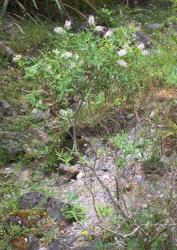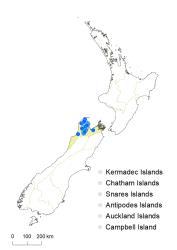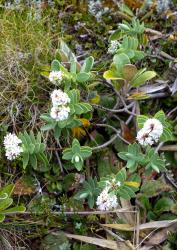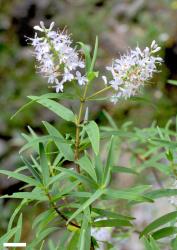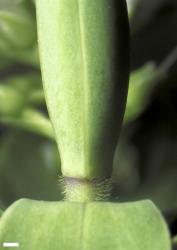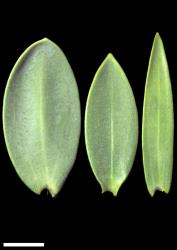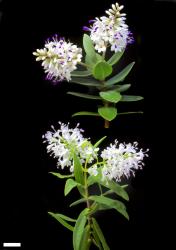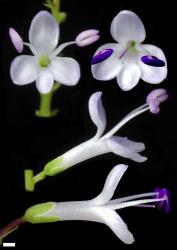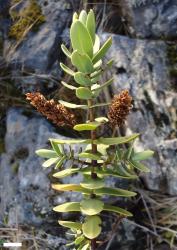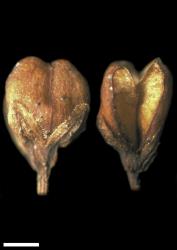- Taxon
- Gallery
- ≡ Hebe albicans (Petrie) Cockayne, Trans. New Zealand Inst. 60: 468 (1929)
- = Hebe recurva G.Simpson & J.S.Thomson, Trans. Roy. Soc. New Zealand 70: 32 (1940)
Low or bushy shrub to 1 m tall. Stems decumbent to erect, or sometimes pendent, eglandular-puberulent to pubescent, hairs bifarious to uniform, or sometimes tufted between leaf bases and in axils, glabrous with age. Leaf bud distinct, its leaves appressed at margins until fully grown; sinus absent. Leaves opposite-decussate, erecto-patent to recurved; lamina coriaceous, linear-lanceolate to lanceolate or ovate to elliptic or oblong, 11–42 mm long, 3–17 mm wide, dull and glaucous above and beneath; midrib evident; 2 lateral veins visible at least when fresh; surfaces glabrous, or sometimes eglandular hairs along midrib above especially near base; margin glabrous, entire; apex obtuse to acute or weakly plicate-acuminate; base cuneate to truncate or cordate and amplexicaul; petiole absent. Inflorescence a lateral raceme, 17–55 mm long; flowers crowded, 15–45, all bisexual; bracts alternate or in irregular whorls, lanceolate, elliptic, or ovate, < to > pedicels; pedicels erecto-patent to spreading, 0.5–3.5 mm, rarely to 6.0 mm long, eglandular-pubescent or -puberulent all around. Calyx lobes 4, rounded to acute, 1.8–3.0 mm long, equal, mixed eglandular- and glandular-ciliolate, sometimes with longer eglandular hairs as well. Corolla 4.5–8.0 mm diameter; tube white, 2.5–6.0 mm long, much > calyx, eglandular hairy inside or rarely glabrous; lobes 4, white, erecto-patent to spreading, unequal, elliptic to ovate, 2.0–3.5 mm long, rounded; nectar guides absent. Stamen filaments white, 3.0–5.5 mm long; anthers magenta. Style glabrous, 4.5–9.0 mm long. Capsules latiseptate, obtuse to sub-acute or slightly emarginate, glabrous, 2.5–4.5 mm long, 2.0–3.2 mm at widest point. Seeds ellipsoid to discoid, flattened, smooth, brown, 1.0–1.8 mm (rarely to 2.0 mm) long.
Although V. albicans is a very variable species, it can be distinguished from other hebes with glaucous leaves. V. topiaria and V. glaucophylla plants have smaller leaves and short corolla tubes, whereas V. simulans, V. cryptomorpha, and V. baylyi plants have a sinus in the vegetative bud. V. pinguifolia plants have sessile flowers and shorter corolla tubes. V. gibbsii plants are similar in many ways, but differ in fringing long hairs on the leaf margins, leaves narrower than many forms of V. albicans, corolla tubes glabrous, and capsules narrower (1.6–2.0 mm wide).
Some plants of V. albicans with large amplexicaul leaves can look similar to V. pareora from South Canterbury, but plants of that species have glabrous stems and inflorescences and larger corolla lobes, and their capsules are barely flattened.
Plants of V. amplexicaulis (from South Canterbury) could be confused with V. albicans, but are distinguished by their shorter corolla tubes and hairy capsules, at least at the apex. V. amplexicaulis plants often have smaller leaves than plants of V. albicans.
South Island: Nelson (common in western Nelson from Mt Burnett southwards and west of the Motueka River), Westland (Glasgow Range), Sounds Nelson (one population at Roding River, Bryant Range).
Rocky places on river banks and gorges to rock outcrops and open places in grassland and forest margins, from lowland to sub-alpine and penalpine altitudes. Often on calcareous rocks. Recorded elevations range from 40 to 1538 m.
Putative hybrids between V. albicans and V. calcicola were discussed by Bayly et al. (2001).
Flowers: November–March, extending to May; fruits: January–August, persisting to November.
2n = 40, 80 (see Bayly & Kellow 2006, as Hebe albicans).
Veronica albicans is classified in V. subg. Pseudoveronica sect. Hebe and the informal group “Occlusae” (Albach & Meudt 2010; Bayly & Kellow 2006).
V. albicans is a very variable species with respect to several morphological characters, flavonoid chemistry, and chromosome number, but diverse populations are united by the large, glaucous leaves and the long corolla tubes. The variation was studied in detail by Kellow et al. (2005), who concluded there was little evidence of correlations among the various character states, geography, and chromosome numbers that would suggest the existence of breeding barriers between groups of populations.
Plants of V. albicans sensu stricto (e.g., from Cobb Valley and Arthur Range) tend to have broad leaves and pubescent stems, and they vary in several other characters. Plants previously assigned to Hebe recurva (from mostly lowland sites, e.g. Aorere River) have narrow leaves, often longer pedicels, and narrow and more acute capsules, and they also vary in other characters. A range of additional populations (including from Mt Burnett, Tākaka Hill, The Gorge Creek, Hoary Head, and Owen Range) include plants that tend to have broad leaves, often short pedicels, and puberulent stems, but vary in other characters. Kellow et al. (2005) provided detailed descriptions of variation and discuss its significance; they concluded there is no clear basis for further subdivision of the complex.
Cultivars
Widely cultivated and also used as a parent in some cultivated hybrids (e.g., some of the ‘Wiri’ series of cultivars, such as hebe ‘Wiri Dawn’ ‘Wiri Desire’ and ‘Wiri Mist’). See http://www.terrain.net.nz/friends-of-te-henui-group/friends-of-te-henui.html for details and photographs.



